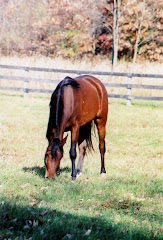 My niece told me that the two sides of her family were very different: Her Dad's side reminded her of the very "proper" British family, while her Mom's side reminded her of the typical boisterous Irish clan. The difference between show hunters and show jumpers can be compared in somewhat similar ways.
My niece told me that the two sides of her family were very different: Her Dad's side reminded her of the very "proper" British family, while her Mom's side reminded her of the typical boisterous Irish clan. The difference between show hunters and show jumpers can be compared in somewhat similar ways.Show hunters, as discussed, have a more polished, quiet and refined manner, and the judging in the ring is very subjective. Not so the very agile, energetic and animated show jumpers. A show jumper will be more elevated, or "up" in front end, and powerful hindquarters should be placed well under its body to help it through tight turns and over larger jumps. Show jumpers tend to be a little more "hot-tempered" than a hunter, as they need the extra boost of enthusiasm to get through the tricky and difficult courses.
The most common myth about show jumpers is that "it's all about speed." Yes, the horse with the best time wins. But it isn't because they were the fastest; it is because they were the most athletic, and their speed combined with the ability to stay focused and respond instantly to the rider's aids while jumping at high speed led them to a clean round with the best time. So speed alone doesn't do it.
Show jumpers are guided over a course of very colorful, elaborate obstacles and are judged on time and faults. There is nothing about the way they look that makes a difference in their final placing, unless it results in a fault. For instance, a horse that hangs his front legs down and doesn't tuck them under his chest, might knock a rail down, which results in 4 faults off their final score. Other faults come from a refusal or run out, circling across his own path (considered a refusal), or going over the maximum time allowed.
Show jumping is one of the flashiest of the Olympic sports. A modified version of show jumping called "stadium jumping," is one phase of eventing competitions (the other two being the dressage phase, and the most popular cross-country courses). Both show hunters and show jumpers will always benefit from the discipline and athleticism that comes from dressage training.
What exactly is dressage? Stay tuned! That's next!
+of+DallasGrazing.jpg)



No comments:
Post a Comment